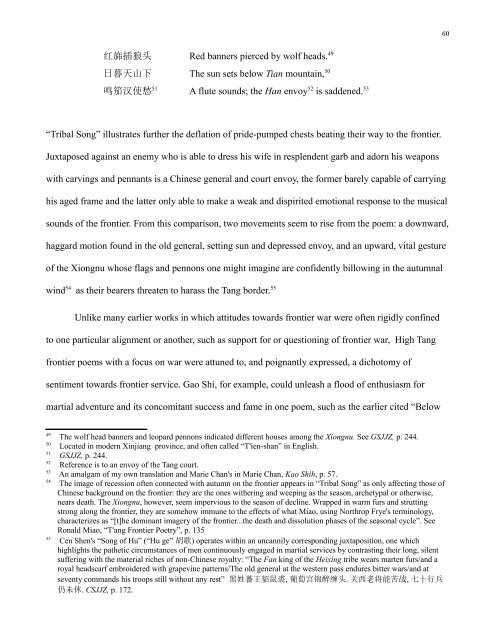View/Open - University of Victoria
View/Open - University of Victoria
View/Open - University of Victoria
Create successful ePaper yourself
Turn your PDF publications into a flip-book with our unique Google optimized e-Paper software.
60<br />
红 旆 插 狼 头 Red banners pierced by wolf heads. 49<br />
日 暮 天 山 下 The sun sets below Tian mountain, 50<br />
鸣 笳 汉 使 愁<br />
51<br />
A flute sounds; the Han envoy 52 is saddened. 53<br />
“Tribal Song” illustrates further the deflation <strong>of</strong> pride-pumped chests beating their way to the frontier.<br />
Juxtaposed against an enemy who is able to dress his wife in resplendent garb and adorn his weapons<br />
with carvings and pennants is a Chinese general and court envoy, the former barely capable <strong>of</strong> carrying<br />
his aged frame and the latter only able to make a weak and dispirited emotional response to the musical<br />
sounds <strong>of</strong> the frontier. From this comparison, two movements seem to rise from the poem: a downward,<br />
haggard motion found in the old general, setting sun and depressed envoy, and an upward, vital gesture<br />
<strong>of</strong> the Xiongnu whose flags and pennons one might imagine are confidently billowing in the autumnal<br />
wind 54 as their bearers threaten to harass the Tang border. 55<br />
Unlike many earlier works in which attitudes towards frontier war were <strong>of</strong>ten rigidly confined<br />
to one particular alignment or another, such as support for or questioning <strong>of</strong> frontier war, High Tang<br />
frontier poems with a focus on war were attuned to, and poignantly expressed, a dichotomy <strong>of</strong><br />
sentiment towards frontier service. Gao Shi, for example, could unleash a flood <strong>of</strong> enthusiasm for<br />
martial adventure and its concomitant success and fame in one poem, such as the earlier cited “Below<br />
49<br />
The wolf head banners and leopard pennons indicated different houses among the Xiongnu. See GSJJZ, p. 244.<br />
50<br />
Located in modern Xinjiang province, and <strong>of</strong>ten called “T'ien-shan” in English.<br />
51<br />
GSJJZ, p. 244.<br />
52<br />
Reference is to an envoy <strong>of</strong> the Tang court.<br />
53<br />
An amalgam <strong>of</strong> my own translation and Marie Chan's in Marie Chan, Kao Shih, p. 57.<br />
54<br />
The image <strong>of</strong> recession <strong>of</strong>ten connected with autumn on the frontier appears in “Tribal Song” as only affecting those <strong>of</strong><br />
Chinese background on the frontier: they are the ones withering and weeping as the season, archetypal or otherwise,<br />
nears death. The Xiongnu, however, seem impervious to the season <strong>of</strong> decline. Wrapped in warm furs and strutting<br />
strong along the frontier, they are somehow immune to the effects <strong>of</strong> what Miao, using Northrop Frye's terminology,<br />
characterizes as “[t]he dominant imagery <strong>of</strong> the frontier...the death and dissolution phases <strong>of</strong> the seasonal cycle”. See<br />
Ronald Miao, “T'ang Frontier Poetry”, p. 135<br />
55<br />
Cen Shen's “Song <strong>of</strong> Hu” (“Hu ge” 胡 歌 ) operates within an uncannily corresponding juxtaposition, one which<br />
highlights the pathetic circumstances <strong>of</strong> men continuously engaged in martial services by contrasting their long, silent<br />
suffering with the material riches <strong>of</strong> non-Chinese royalty: “The Fan king <strong>of</strong> the Heixing tribe wears marten furs/and a<br />
royal headscarf embroidered with grapevine patterns/The old general at the western pass endures bitter wars/and at<br />
seventy commands his troops still without any rest” 黑 姓 蕃 王 貂 鼠 裘 , 葡 萄 宫 锦 醉 缠 头 . 关 西 老 将 能 苦 战 , 七 十 行 兵<br />
仍 未 休 . CSJJZ, p. 172.
















